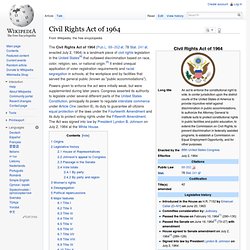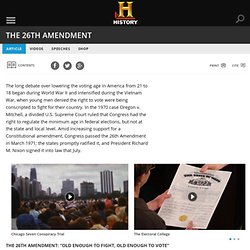

U.S. Constitution - Amendment 24. Civil Rights Act of 1964 - Wiki. The Civil Rights Act of 1964 (Pub.L. 88–352, 78 Stat. 241, enacted July 2, 1964) is a landmark piece of civil rights legislation in the United States[4] that outlawed discrimination based on race, color, religion, sex, or national origin.[5] It ended unequal application of voter registration requirements and racial segregation in schools, at the workplace and by facilities that served the general public (known as "public accommodations").

Powers given to enforce the act were initially weak, but were supplemented during later years. Congress asserted its authority to legislate under several different parts of the United States Constitution, principally its power to regulate interstate commerce under Article One (section 8), its duty to guarantee all citizens equal protection of the laws under the Fourteenth Amendment and its duty to protect voting rights under the Fifteenth Amendment. The Act was signed into law by President Lyndon B. Johnson on July 2, 1964 at the White House.
John F. Ratification of Constitutional Amendments. Article 5 of the Constitution provides for the amendment of the Constitution by various means (see The Amendments Page for details). However an amendment is proposed, it does not become part of the Constitution unless it is ratified by three-quarters of the states (either the legislatures thereof, or in amendment conventions). The following is a record of each ratified amendment and the states and dates that led to the ratification. The Constitutional Timeline and the Ratification Grid may also be of interest. The information contained on this page was found on the Amendments to the Constitution Page at Emory University's site and on the Text of the Amendments Page at the GPO's site. As noted on those pages, the dates published here are based on the best information available. There is some disagreement about the ability of a state to rescind an amendment ratification prior to full ratification.
The 11th Amendment, which limits Supreme Court jurisdiction, was proposed on March 4, 1794. The 26th Amendment — History.com Articles, Video, Pictures and Facts. On March 10, 1971, the U.S.

Senate voted unanimously in favor of the proposed amendment. After an overwhelming House vote in favor on March 23, the 26th Amendment went to the states for ratification. In just over two months–the shortest period of time for any amendment in U.S. history–the necessary three-fourths of state legislatures (or 38 states) ratified the 26th Amendment, and President Nixon signed it into law that July. At a White House ceremony attended by 500 newly eligible voters, Nixon declared: “The reason I believe that your generation, the 11 million new voters, will do so much for America at home is that you will infuse into this nation some idealism, some courage, some stamina, some high moral purpose, that this country always needs.”
Though newly minted young voters were expected to choose Democratic challenger George McGovern, an opponent of the Vietnam War, Nixon was reelected by an overwhelming margin–winning 49 states–in 1972.